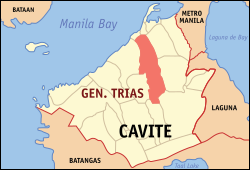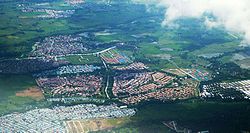
Antipolo, officially the City of Antipolo, is a 1st class component city and capital of the province of Rizal, Philippines. According to the 2015 census, it has a population of 776,386 people. It is the most populous city in the Calabarzon region, and the eighth most-populous city in the Philippines.

Kawit, officially the Municipality of Kawit, is a first-class municipality in the province of Cavite, Philippines. According to the 2015 census, it has a population of 83,466. It is one of the notable places that had a major role in the country's history during the 1800s and 1900s.

Tanza, officially the Municipality of Tanza, formerly known as Santa Cruz de Malabón, is a 1st class municipality in the province of Cavite, Philippines. According to the 2015 census, it has a population of 226,188 people. It has a land area of 78.24 square kilometres (30.21 sq mi).
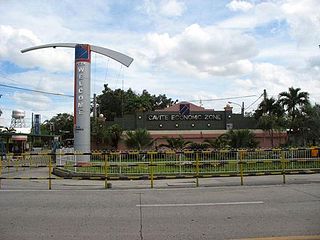
Rosario, officially the Municipality of Rosario, is a 1st class municipality in the province of Cavite, Philippines. According to the 2015 census, it has a population of 110,706 people.

Carmona, officially the Municipality of Carmona, is a 1st class municipality located in the province of Cavite, Philippines. According to the 2015 census, it has a population of 97,557 people.
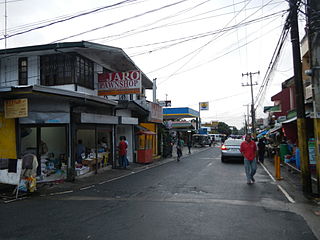
Alfonso, officially the Municipality of Alfonso, is a 1st class municipality in the province of Cavite, Philippines. According to the 2015 census, it has a population of 51,839 people.

General Mariano Alvarez, officially the Municipality of General Mariano Alvarez and often shortened as GMA, is a 1st class municipality in the province of Cavite, Philippines. According to the 2015 census, it has a population of 155,143 people.

Trece Martires, officially the City of Trece Martires, is a 4th class component city and de facto capital city of the province of Cavite, Philippines. According to the 2015 census, it has a population of 155,713 people.
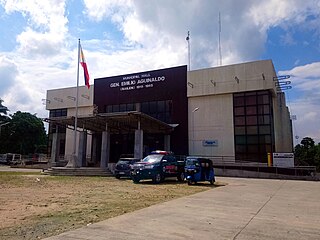
General Emilio Aguinaldo, officially the Municipality of General Emilio Aguinaldo, is a 5th class municipality in the province of Cavite, Philippines. According to the 2015 census, it has a population of 22,220 people.
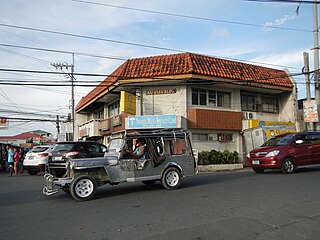
Noveleta, officially the Municipality of Noveleta, formerly known as Tierra Alta during the Spanish colonial era, is a 3rd class municipality in the province of Cavite, Philippines. According to the 2015 census, it has a population of 45,846 people.

Silang, officially the Municipality of Silang, is a 1st class municipality in the province of Cavite, Philippines. According to the 2015 census, it has a population of 248,085 people.

Buenavista, officially the Municipality of Buenavista, is a 4th class municipality in the province of Quezon, Philippines. According to the 2015 census, it has a population of 30,047 people.

Artemio Ricarte y García was a Filipino general during the Philippine Revolution and the Philippine–American War. He is regarded as the Father of the Philippine Army, and the first Chief of Staff of the Armed Forces of the Philippines though the present Philippine Army descended from the American-allied forces that defeated the Philippine Revolutionary Army led by General Ricarte. Ricarte is notable for never having taken an oath of allegiance to the United States government that occupied the Philippines from 1898 to 1946.

Mariano Trías y Closas is considered to be the first de facto Philippine Vice President of that revolutionary government established at the Tejeros Convention - an assembly of Philippine revolutionary leaders that elected officials of the revolutionary movement against the colonial government of Spain. When that assembly broke into factions, a truce known as the Pact of Biak-na-Bato was signed by the group and also recognized the elected officials and Trias as the vice president of Emilio Aguinaldo, who is also considered to be the first President of the Philippines. With the promulgation of the Malolos Constitution by the Malolos Convention, the First Philippine Republic was born. Under the Aguinaldo administration, Trias served in the cabinet initially as Secretary of Finance and, later, as Secretary of War.

The Tejeros Convention was the meeting held on March 22, 1897 between the Magdiwang and Magdalo factions of the Katipunan at San Francisco de Malabon (now General Trias, Cavite. These are the first presidential and vice presidential elections in Philippine history, although only the Katipuneros were able to take part, and not the general populace.

The Magdiwang was a chapter of the Katipunan, a Philippine revolutionary organization founded by Filipino rebels in Manila in 1892, with the aim to gain independence from Spain. The Magdiwang Council was acknowledged "as the supreme organ responsible for the successful campaigns against the enemy."

Juanito Remulla Sr. Road, formerly and still referred to as Governor's Drive, is a two-to-nine lane, 58.3-kilometer (36.2 mi) network of primary, secondary and tertiary highways and bridges traversing through the central cities and municipalities of the province of Cavite, Philippines. It is the widest of the three major highways located in the province, the others are Aguinaldo Highway and Antero Soriano Highway.

The Battle of Noveleta was a major battle during the Philippine revolution and was one of the first engagements of the revolution in Cavite. In the latter part of the revolution, Noveleta played a key role for the Magdalo and Magdiwang factions. From its capture by the Magdiwang at the start of the revolution, various battles were fought and won by Filipino rebels in Cavite. Noveleta became the seat of the Magdiwang faction of the Katipunan.
The Zamboanga City Council is Zamboanga City's Sangguniang Panlungsod or local legislature.

The Cavite Provincial Board is the Sangguniang Panlalawigan of the Philippine province of Cavite.
